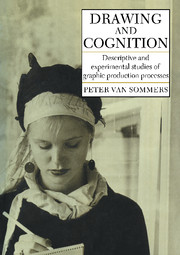Book contents
- Frontmatter
- Contents
- Preface
- 1 Basic executive constraints in drawing
- 2 Maintaining paper contact, anchoring, and planning
- 3 The reproduction of rectilinear figures
- 4 The production of curvilinear forms
- 5 The impact of meaning on executive strategies
- 6 Simple representational drawing
- 7 Difficult graphic tasks: A failure in perceptual analysis?
- 8 Stability and evolution in children's drawings
- 9 Innovations, primitives, contour, and space in children's drawings
- 10 Children's repeated drawings: How are innovations coded?
- 11 The pragmatics of everyday graphic production
- References
- Index
5 - The impact of meaning on executive strategies
Published online by Cambridge University Press: 07 October 2011
- Frontmatter
- Contents
- Preface
- 1 Basic executive constraints in drawing
- 2 Maintaining paper contact, anchoring, and planning
- 3 The reproduction of rectilinear figures
- 4 The production of curvilinear forms
- 5 The impact of meaning on executive strategies
- 6 Simple representational drawing
- 7 Difficult graphic tasks: A failure in perceptual analysis?
- 8 Stability and evolution in children's drawings
- 9 Innovations, primitives, contour, and space in children's drawings
- 10 Children's repeated drawings: How are innovations coded?
- 11 The pragmatics of everyday graphic production
- References
- Index
Summary
The study I am about to report shows that what a drawing represents can affect the strategy of its production; final execution is not by any means monopolized by the formal geometric aspects of making lines on paper. To give a simple example, an arrow pointing to the left is, geometrically, a horizontal line with a pair of shorter oblique lines running diagonally back from its left-hand end. Formal graphic constraints invite the right-handed drawer to make the major stroke from left to right, but its representational significance may promote the reverse, a stroke that moves in the direction the arrow points. This does not mean that geometric constraints become irrelevant. Rather, the drawer's action in any particular instance may result from cooperation or competition between the two forces, geometric and semantic. The context of drawing may modulate this interaction, biasing it in one direction or the other. The more the context emphasizes meaning and the less routinized it is, the more likely it is that semantics will prevail over geometry at the point of action, should they be opposed.
Drawing and speech
Before outlining an analysis and demonstration of this interplay in drawing and copying, I should like to compare the structure of drawing and speech production from this point of view. On the whole, semantics and pragmatics do not intrude on mainstream executive processes in speech.
- Type
- Chapter
- Information
- Drawing and CognitionDescriptive and Experimental Studies of Graphic Production Processes, pp. 95 - 114Publisher: Cambridge University PressPrint publication year: 1984



